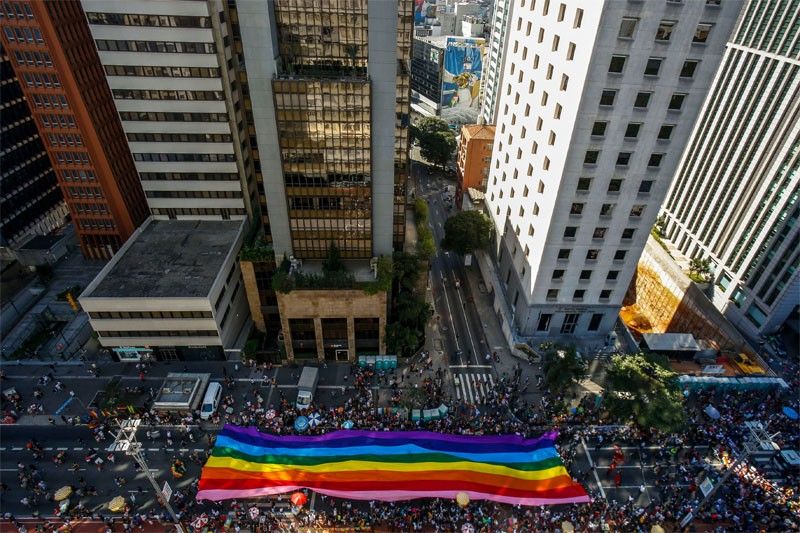A look back at the Stonewall uprising, a milestone for gay rights

NEW YORK, United States — Mark Segal has no trouble recalling the early hours of June 28, 1969—when the first in a series of violent protests by members of New York's gay community erupted outside the now-legendary Stonewall Inn.
In the wee hours of that Saturday, a hot night in Manhattan, a group of lesbians, drag queens, transgender people and young, gay men including Segal decided to stand up to police abuse.
They cornered a group of officers who had earlier raided the Stonewall Inn, a seedy, popular gay bar in Greenwich Village—the second such raid that week alone.
"It was the first time our community imprisoned the police, who had always imprisoned us before," Segal told AFP, looking back on what would become a seminal event in the gay rights movement.
Segal was only 18 at the time, and had come to New York from Philadelphia just over a month earlier. He said he can still remember the "pure joy" of that night.
"The passion was so overwhelming," he said, adding that of course, no one then understood the historic significance of what was unfolding.
In the late 1960s, homosexuality was still seen as a mental illness, and gay sex was illegal across the United States except in Illinois.
Millions of gay and lesbian Americans lived their lives in secret, for fear they would lose their jobs or homes if their true selves were discovered.
Some were openly attacked, and others were detained for indecent behavior.
Safe haven
The Stonewall Inn on Christopher Street was run by New York's Mafia, sold alcohol without a permit—but famously watered down the drinks.
The bar was known for its huge jukebox and for being the only gay bar where there was dancing, even slow dancing.
In short, it was a safe haven for a community long accustomed to being treated with intolerance.
"The Stonewall Inn was an amazing place," recalled 71-year-old Martin Boyce, standing in front of the bar, which is now a national historic monument.
"You could be yourself in that bar—even if it was Mafia-run, even if it was a dump... we were just glad to have anything."
On the eve of the Stonewall uprising, change was in the air.
The civil rights and equal rights movements were in full swing, Latinos were staking their claim to better protections, the sexual revolution was changing attitudes about sex, and students were protesting the Vietnam war.
But historian David Carter—author of the 2004 book "Stonewall: The Riots That Sparked The Gay Revolution"—notes that the Mattachine Society, founded in 1950 to promote gay rights, had already notched some significant advances by that point.
The legalization of gay bars, for example, had ignited hope in the community. The society also worked to put a stop to police entrapment of gays and lesbians.
When Boyce, the son of a New York taxi driver, arrived at the Stonewall Inn that Friday night with a friend, the bar was jam-packed and the raid was underway.
Between those thrown out of the bar by the police and those who had gathered outside, the crowd was about 200-strong.
Boyce said he saw a police paddy wagon and then, "this very brutal cop was pushing some queen and she kicked him in the shoulder with her heel."
"He went back into the truck. You heard a banging, a moaning, bone and flesh, sting of metal," and the cop ordered the crowd to disperse, he recalled. The crowd was furious.
"There was a movement to do what he said as always," Boyce said.
"But we didn't do what he said—we started walking towards him."
'Ready to fight'
Boyce said the officer grabbed his billy club "to give us the ultimate threat in the ultimate tone," but added: "He never got a chance to say it."
"Whatever was in our faces... he was unnerved. He just fell apart and ran into the bar as the rest of the police ran into the bar."
Protesters formed a semi-circle in front of the Stonewall Inn and initially threw pennies—a sign of disrespect, copper coins for the "coppers."
Then the situation escalated, Boyce recounted. Protesters hurled bottles, cans, rocks, bricks and Molotov cocktails at police.
The demonstrators ripped a parking meter out of the ground and tried to use it to force open the door of the bar, where the police had sought shelter. Some even tried to set the building on fire.
"There was a consensus... We were ready to fight," he said.
The unrest lasted through the night.
"They didn't get us," said Boyce, who sustained a blow to the back that night. "We wore them out. (...) All night, they chased us. They could not stop the riot and somehow we knew we couldn't stop it."
In all, 13 protesters were arrested, and at least one police officer was hurt.
Demonstrators called for fresh protests the following day, getting the word out by writing in chalk on sidewalks and walls in the neighborhood.
The second night, an even larger crowd turned out, and more violence ensued.
"It became a contest over who owned who, who had the right to control the area," Carter said.
"This was the heart of the gay ghetto."
Six nights of protests gave rise to the modern gay rights movement, and to pioneering advocacy groups like the Gay Liberation Front and the Gay Activist Alliance.
For Boyce, a chef, "Stonewall is a verb—it's an action word and it will always be."
"We made it a big thing, that bar, and it gave us liberation. Good trade-off!" he said with a laugh.
- Latest



























